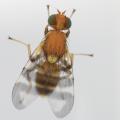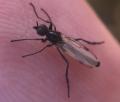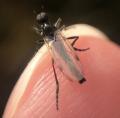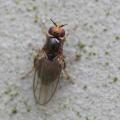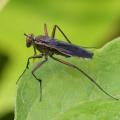Diptera.info :: Identification queries :: Diptera (adults)
Who is here? 1 guest(s)
|
Aplomya confinis?
|
|
| PeterD |
Posted on 14-11-2009 22:36
|
|
Member Location: Portsmouth UK Posts: 297 Joined: 08.11.09 |
This is the closest match I have found. Can someone please confirm or suggest an alternative? Thankyou Kind regards Peter www.imageinuk.com |
| ChrisR |
Posted on 14-11-2009 23:52
|
|
Administrator Location: Reading, England Posts: 7699 Joined: 12.07.04 |
Do you have any more angles? I think Aplomya confinis shouldn't have median discal bristles on tergites 3 & 4 but the fly in your photo does have them so I'd suggest it is more likely to be a Phryxe sp. or Epicampocera succincta 
Manager of the UK Species Inventory in the Angela Marmont Centre for UK Biodiversity at the Natural History Museum, London. |
| PeterD |
Posted on 15-11-2009 13:24
|
|
Member Location: Portsmouth UK Posts: 297 Joined: 08.11.09 |
ChrisR wrote: Do you have any more angles? I think Aplomya confinis shouldn't have median discal bristles on tergites 3 & 4 but the fly in your photo does have them so I'd suggest it is more likely to be a Phryxe sp. or Epicampocera succincta  I think you are correct, thank you. Looking through the gallery on here I think it is more likely P. vulgaris - what do you think? Unfortunately, I do not have any other angles but have learnt, since being on here, that a number of angles makes ID far easier  and I shall try it in future. Critical angles seem to be wing, face and dorsal. Its quite an accomplishment for me to identify it as a Tachnidae (believe me) and I shall try it in future. Critical angles seem to be wing, face and dorsal. Its quite an accomplishment for me to identify it as a Tachnidae (believe me) so I am learning so I am learning . .
Kind regards Peter www.imageinuk.com |
| ChrisR |
Posted on 15-11-2009 15:15
|
|
Administrator Location: Reading, England Posts: 7699 Joined: 12.07.04 |
Well, Tachinidae is easy - bluebottle-shaped fly with thick bristles and bent median vein (this rule-of-thumb doesn't work for all of them but it proves the case with flies like this). Using photos as your primary means of identifying is a very risky business - the gallery is incomplete and unless you know exactly what you are looking for (usually arrangements of bristles and wing venation) then you're likely just to pick a fly that looks superficially like your photo but is very wide of the mark in terms of an ID  On this photo the fly clearly has hairy eyes; nothing much remarkable about the wing venation; and bristles on the edges and the middle of the upper abdominal segments (tergites) so there's a few things it could be. Phryxe would usually have an orange-tipped scutellum with raised apical bristles but I can't see those ... and it does look quite dark-blue in colour which might suggest Epicampocera  As far as angles go you really need to get as many as you can - I usually prefer dorso-lateral because you get a few things in that but you need to see the head, wings, thorax & abdomen pretty clearly 
Manager of the UK Species Inventory in the Angela Marmont Centre for UK Biodiversity at the Natural History Museum, London. |
| PeterD |
Posted on 15-11-2009 16:08
|
|
Member Location: Portsmouth UK Posts: 297 Joined: 08.11.09 |
ChrisR wrote: Well, Tachinidae is easy - bluebottle-shaped fly with thick bristles and bent median vein (this rule-of-thumb doesn't work for all of them but it proves the case with flies like this). Using photos as your primary means of identifying is a very risky business - the gallery is incomplete and unless you know exactly what you are looking for (usually arrangements of bristles and wing venation) then you're likely just to pick a fly that looks superficially like your photo but is very wide of the mark in terms of an ID  On this photo the fly clearly has hairy eyes; nothing much remarkable about the wing venation; and bristles on the edges and the middle of the upper abdominal segments (tergites) so there's a few things it could be. Phryxe would usually have an orange-tipped scutellum with raised apical bristles but I can't see those ... and it does look quite dark-blue in colour which might suggest Epicampocera  As far as angles go you really need to get as many as you can - I usually prefer dorso-lateral because you get a few things in that but you need to see the head, wings, thorax & abdomen pretty clearly  Thank you Chris for your full explanation. Believe me, I find this very helpful. I have only just accepted that there are more flies than bluebottles, greenbottles and houseflies  . I have downloaded and used the BC Diptera Guide. It's proved an interested read and the 'pencil sketch' illustrations are far better than photos to get to the various families. After this though, I have found I have to rely on images. I am sure that, with practise, I shall be able to improve on my ID skills. The other good thing I have found in the BC Dipteria guide is the terminology section. Without it I would find it imposible to follow the points made on here. . I have downloaded and used the BC Diptera Guide. It's proved an interested read and the 'pencil sketch' illustrations are far better than photos to get to the various families. After this though, I have found I have to rely on images. I am sure that, with practise, I shall be able to improve on my ID skills. The other good thing I have found in the BC Dipteria guide is the terminology section. Without it I would find it imposible to follow the points made on here.I shall now look for more images to help. Thanks also for your guide on the important features to record for ID purposes. I shall be taking a lot more images now but - with digital, this costs nothing  but increases the chances for an ID. but increases the chances for an ID.
Kind regards Peter www.imageinuk.com |
| ChrisR |
Posted on 15-11-2009 16:25
|
|
Administrator Location: Reading, England Posts: 7699 Joined: 12.07.04 |
PeterD wrote: The other good thing I have found in the BC Dipteria guide is the terminology section. Without it I would find it imposible to follow the points made on here. That's true - we have a Glossary on diptera.info too, which can be helpful. I try to keep descriptions simple to novices but it is hard to be precise without using buzz-words every now and then ... and it anyway shows that the subject is a bit more complicated than most people give it credit for  Do you have a link for the BC guide - I'd be interested to read it myself to see what kind of advice it gives 
Manager of the UK Species Inventory in the Angela Marmont Centre for UK Biodiversity at the Natural History Museum, London. |
| Roger Thomason |
Posted on 15-11-2009 17:26
|
|
Member Location: Mossbank,Shetland Isles. Posts: 5248 Joined: 17.07.08 |
ChrisR wrote: quote] That's true - we have a Glossary on diptera.info too, which can be helpful. I try to keep descriptions simple to novices but it is hard to be precise without using buzz-words every now and then ... and it anyway shows that the subject is a bit more complicated than most people give it credit for  Do you have a link for the BC guide - I'd be interested to read it myself to see what kind of advice it gives  Andrzej posted the link in Shoutbox on 11.11.09  |
|
|
|
| PeterD |
Posted on 15-11-2009 17:44
|
|
Member Location: Portsmouth UK Posts: 297 Joined: 08.11.09 |
ChrisR wrote: PeterD wrote: The other good thing I have found in the BC Dipteria guide is the terminology section. Without it I would find it imposible to follow the points made on here. That's true - we have a Glossary on diptera.info too, which can be helpful. I try to keep descriptions simple to novices but it is hard to be precise without using buzz-words every now and then ... and it anyway shows that the subject is a bit more complicated than most people give it credit for  Do you have a link for the BC guide - I'd be interested to read it myself to see what kind of advice it gives  The pdf doc is at http://www.for.go...62001b.pdf I am exploring similar links for the other insects I am interesting in. Edited by ChrisR on 15-11-2009 19:38 Kind regards Peter www.imageinuk.com |
| PeterD |
Posted on 15-11-2009 17:45
|
|
Member Location: Portsmouth UK Posts: 297 Joined: 08.11.09 |
Roger Thomason wrote: ChrisR wrote: quote] That's true - we have a Glossary on diptera.info too, which can be helpful. I try to keep descriptions simple to novices but it is hard to be precise without using buzz-words every now and then ... and it anyway shows that the subject is a bit more complicated than most people give it credit for  Do you have a link for the BC guide - I'd be interested to read it myself to see what kind of advice it gives  Andrzej posted the link in Shoutbox on 11.11.09  Thanks Roger. I had the link to hand and have posted it to Chris Kind regards Peter www.imageinuk.com |
| ChrisR |
Posted on 15-11-2009 19:49
|
|
Administrator Location: Reading, England Posts: 7699 Joined: 12.07.04 |
PeterD wrote: The pdf doc is at http://www.for.go...62001b.pdf I am exploring similar links for the other insects I am interesting in. Unwin's key to the families of British Diptera might be more appropriate and less complicated than the BC key. I am always a bit wary of using foreign keys because they have to include families that we don't have here and their methods (the path the key takes) reflect this. 
Manager of the UK Species Inventory in the Angela Marmont Centre for UK Biodiversity at the Natural History Museum, London. |
| PeterD |
Posted on 15-11-2009 21:15
|
|
Member Location: Portsmouth UK Posts: 297 Joined: 08.11.09 |
ChrisR wrote: PeterD wrote: The pdf doc is at http://www.for.go...62001b.pdf I am exploring similar links for the other insects I am interesting in. Unwin's key to the families of British Diptera might be more appropriate and less complicated than the BC key. I am always a bit wary of using foreign keys because they have to include families that we don't have here and their methods (the path the key takes) reflect this.  Thank you Chris. I have read the document partially to get the flavour. This is without doubt going to be very useful to me  . I shall have to spend a few days going through this before attempting to use it for my own ID purposes. . I shall have to spend a few days going through this before attempting to use it for my own ID purposes.
Kind regards Peter www.imageinuk.com |
| Jaakko |
Posted on 16-11-2009 08:26
|
|
Member Location: Joensuu, Finland Posts: 479 Joined: 04.08.08 |
Hi, From the options Chris listed, I would vote E. succincta as the specimen looks quite blueish-black. However, I couldn't rule out Platymya fimbriata or Eumea sp. either. Nice to see that people are motivated to start learning diptera-families, Peter! As with everything, it takes some effort to start mastering them. I've given up hope with most and try to stick with the interesting ones... Jaakko attached the following image: [9.93Kb] Edited by Jaakko on 16-11-2009 08:28 |
|
|
|
| PeterD |
Posted on 16-11-2009 09:29
|
|
Member Location: Portsmouth UK Posts: 297 Joined: 08.11.09 |
Jaakko wrote: Hi, From the options Chris listed, I would vote E. succincta as the specimen looks quite blueish-black. However, I couldn't rule out Platymya fimbriata or Eumea sp. either. Nice to see that people are motivated to start learning diptera-families, Peter! As with everything, it takes some effort to start mastering them. I've given up hope with most and try to stick with the interesting ones... Thank you Jaakko. I shall have to master the families first then ID further. I see what you mean though, it is not always an easy task to get to this level in all cases and certainly not without a key  . .I thank you also for your suggestions. I could have been more helpful with more shots at different angles but that opportunity has been lost now 
Kind regards Peter www.imageinuk.com |
| ChrisR |
Posted on 16-11-2009 10:42
|
|
Administrator Location: Reading, England Posts: 7699 Joined: 12.07.04 |
Out of interest Peter, when did you see this and where in the country? Although we should never try to identify something from rarity, habitat or flight-period, when it comes to photos (which are an inexact science anyway) it can help. Eumea linearicornis was fairly common at the end of summer in my area ... Epicampocera was very common in mid-summer. Platymya fimbriata is uncommon here, in my experience but I collect in a fairly small geographic and habitat range  Getting to grips with Diptera families can be great fun and it's a real eye-opener to the diversity of flies in the British countryside - you will never look at a fly in the same way again!  Most people tend to specialize in one family (e.g. hoverflies or tachinids) and so after a few months you tend to get a good feel for what your chosen group looks like and so you don't have to use the family key again ... you just keep in mind the main features that prove you are looking at one of your chosen family and you don't have to worry about what defines everything else, so it isn't as bad as it might seem when presented with Unwin's key Most people tend to specialize in one family (e.g. hoverflies or tachinids) and so after a few months you tend to get a good feel for what your chosen group looks like and so you don't have to use the family key again ... you just keep in mind the main features that prove you are looking at one of your chosen family and you don't have to worry about what defines everything else, so it isn't as bad as it might seem when presented with Unwin's key 
Manager of the UK Species Inventory in the Angela Marmont Centre for UK Biodiversity at the Natural History Museum, London. |
| PeterD |
Posted on 16-11-2009 12:58
|
|
Member Location: Portsmouth UK Posts: 297 Joined: 08.11.09 |
ChrisR wrote: Out of interest Peter, when did you see this and where in the country? Although we should never try to identify something from rarity, habitat or flight-period, when it comes to photos (which are an inexact science anyway) it can help. Eumea linearicornis was fairly common at the end of summer in my area ... Epicampocera was very common in mid-summer. Platymya fimbriata is uncommon here, in my experience but I collect in a fairly small geographic and habitat range  Getting to grips with Diptera families can be great fun and it's a real eye-opener to the diversity of flies in the British countryside - you will never look at a fly in the same way again!  Most people tend to specialize in one family (e.g. hoverflies or tachinids) and so after a few months you tend to get a good feel for what your chosen group looks like and so you don't have to use the family key again ... you just keep in mind the main features that prove you are looking at one of your chosen family and you don't have to worry about what defines everything else, so it isn't as bad as it might seem when presented with Unwin's key Most people tend to specialize in one family (e.g. hoverflies or tachinids) and so after a few months you tend to get a good feel for what your chosen group looks like and so you don't have to use the family key again ... you just keep in mind the main features that prove you are looking at one of your chosen family and you don't have to worry about what defines everything else, so it isn't as bad as it might seem when presented with Unwin's key  Chris Thanks for your reply and encouragement to learn Diptera. You are correct in describing the complexities but with practise and with a bit of research, I am sure I can improve. I am already pretty confident in the Hoverflies - but that is only ONE family. The photo was taken 12 October 2009 on ground partially cleared for building on at Waterlooville. It is old farmland where most of the original hedegrow plants are extant and cthe cleared areas have thistles, grasses, nettles etc, including some seeded cultivated plants, growing. No work has taken place here for more than a year due to the recession. I have found this area full of interesting insects throughout the summer and, even now, can be relied upon to provide me with subjects for photography. Kind regards Peter www.imageinuk.com |
| ChrisR |
Posted on 16-11-2009 15:43
|
|
Administrator Location: Reading, England Posts: 7699 Joined: 12.07.04 |
PeterD wrote: No work has taken place here for more than a year due to the recession. I have found this area full of interesting insects throughout the summer and, even now, can be relied upon to provide me with subjects for photography. That's the great irony about brownfield sites - the government & developers think that they are just wastelands but for invertebrates they are a very valuable habitat. In contrast many protected greenfield areas are just agricultural monocultures with little or no wildlife merit. A cynical person might suppose that the protection of greenfield is more about protecting landscapes and less about protecting biodiversity 
Manager of the UK Species Inventory in the Angela Marmont Centre for UK Biodiversity at the Natural History Museum, London. |
| PeterD |
Posted on 16-11-2009 17:16
|
|
Member Location: Portsmouth UK Posts: 297 Joined: 08.11.09 |
ChrisR wrote: PeterD wrote: No work has taken place here for more than a year due to the recession. I have found this area full of interesting insects throughout the summer and, even now, can be relied upon to provide me with subjects for photography. That's the great irony about brownfield sites - the government & developers think that they are just wastelands but for invertebrates they are a very valuable habitat. In contrast many protected greenfield areas are just agricultural monocultures with little or no wildlife merit. A cynical person might suppose that the protection of greenfield is more about protecting landscapes and less about protecting biodiversity  I find that it is hardly surprising. Usually some focus group or other gets involved with greenfield sites and carries with them a list of species they want to protect. The sites are then created to foster for the target species and their dependant species which guarantees success for the project but at the detriment to other species that find their habitat removed. Biodiversity it is not - conservation for some it is. There are of course a few notable exceptions. Kind regards Peter www.imageinuk.com |
| Zeegers |
Posted on 19-11-2009 21:16
|
|
Member Location: Soest, NL Posts: 18539 Joined: 21.07.04 |
Definitely not Aplomhyia and I'd go for Epicampocera as well. Pales, the other option, has scutellum red in common species. Theo |
|
|
|
| PeterD |
Posted on 19-11-2009 22:03
|
|
Member Location: Portsmouth UK Posts: 297 Joined: 08.11.09 |
Zeegers wrote: Definitely not Aplomhyia and I'd go for Epicampocera as well. Pales, the other option, has scutellum red in common species. Theo Thank you Theo. It seems that Epicampocera.succincta gets the most votes and I do not think I could expect more from my single photo. Thanks all who have replied to this thread. Apart from trying to discover the ID if this fly I have learnt a lot with the helpful comments and also a special thanks to Chris for giving the link to the UK Diptera families  . .
Kind regards Peter www.imageinuk.com |
| Jump to Forum: |




